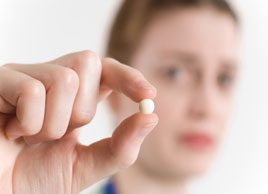Could your medication be harming your health?
Here’s a look at some commonly used drugs, with tips to help you minimize your risk for medication side effects. Always talk to your doctor about what’s right for you

Source: Best Health Magazine, January/February 2009
1. Cholesterol-lowering medications
Statins (drugs such as Crestor, Lipitor and Zocor) have become the most commonly prescribed drugs in Canada. In 2007, Canadians had 23.5 million prescriptions filled.
Need to know
‘ Studies show the relationship between high cholesterol and death from coronary heart disease weakens as women age.
‘ Statins can cause medication side effects such as muscle problems and weakness that can interfere with balance and the ability to exercise, and, in severe cases, can lead to kidney failure.
‘ A comparison of statin treatment and exercise in 250 patients with diabetes over the course of a year found that the statin prevented one death, while walking for two hours a week prevented four deaths in formerly inactive patients.
The options
‘ If you have previously had a heart attack or other vascular occlusive disease, taking a statin is probably a good idea. Talk to your doctor about what’s best for you.
‘ Don’t rely on statins alone to lower cholesterol. Consider some lifestyle changes as well, such as improving your diet, stopping smoking and getting some exercise.
2. Antibiotics
Erythromycin, a commonly used antibiotic for treating bacterial infections such as strep throat and pneumonia, has been on the market for 50-plus years. About 300,000 prescriptions were filled in 2007.
Need to know
‘ If you’re taking any medication that is a CYP3A4 (an enzyme) inhibitor’which includes some oral antifungals and calcium channel blockers (for hypertension), as well as a number of antidepressants’be careful to avoid taking erythromycin, because your risk of having a fatal heart attack could increase fivefold, according to a 2004 study from Vanderbilt University in Nashville. The reason is that CYP3A4 inhibitors slow the breakdown of erythromycin, concentrating it in the bloodstream.
‘ Grapefruit juice is also a CYP3A4 inhibitor and thus potentially dangerous when combined with erythromycin.
The options
‘ ‘Most people can take erythromycin without danger,’ explains Dr. Jim Wright, a clinical pharmacologist and professor in the anesthesiology, pharmacology and therapeutics department at the University of British Columbia. However, if you are taking other medications, check with your physician or pharmacist before you start on this medication.
‘ Ask your doctor whether it’s better for you to use amoxicillin or another antibiotic instead of erythromycin. Depending on what type of infection you have, they can be just as effective.
‘ If you’re taking erythromycin, avoid drinking grapefruit juice.
3. Prescription drugs for arthritis pain
The COX-2 inhibitor celecoxib (Celebrex), an NSAID (non-steroidal anti-inflammatory drug), reduces the pain and swelling of arthritis. Some 2.3 million prescriptions were filled for it in Canada in 2007.
‘ As with all NSAIDs’which include over-the-counter (OTC) products and prescription products including celecoxib’there is a risk of gastrointestinal and cardiovascular medication side effects.
‘ Regular NSAIDs (i.e., not celecoxib) generally offer better protection against cardiovascular side effects than celecoxib does.
‘ Celecoxib generally offers better protection against gastric side effects than any other NSAIDs do.
The options
‘ If you’re at risk for cardiovascular disease, speak to your doctor about what’s right for you. Regular NSAIDs are generally just as effective as celecoxib at controlling pain. If you have problems with stomach irritation, ask if you need a stomach-protecting drug like a proton pump inhibitor or PPI along with the NSAID.
‘ Always take the lowest effective dose of any NSAID to relieve your pain, and take it as infrequently and for as short a time as possible. Stop taking it if you get no relief after two or three days.
4. Drugs to treat bone thinning
Many women take bisphosphonates (like Fosamax and Actonel) to treat bone thinning. Some 6.5 million prescriptions were filled in 2007.
Need to know
‘ Some studies have suggested a possible link between the use of bisphosphonates and atrial fibrillation (rapid/irregular heart rate). Other studies show no link.
‘ Cases of osteonecrosis of the jaw (or ‘jaw death’) have been reported, often following tooth extraction, in women who have been treated for cancer with bisphosphonates. There have also been cases in women treated for osteoporosis.
‘ Contends Wright: ‘We are treating many women over a long period of time, putting them at risk for side effects’yet they have a relatively minor risk of fractures.’
The options
‘ As always, discuss the benefits and risks of bone-building drugs with your doctor.
‘ Strengthen bones by committing to lifestyle changes including exercising, giving up smoking, eating a balanced diet and taking extra calcium and vitamin D.
‘ Pump some iron. Studies have consistently shown that strength training can boost bone density.
‘ Put on a backpack. ‘We know that if you weigh more, your bones are stronger,’ says Wright. ‘So carry a bit of weight in a backpack when you go for a walk.’
This article was originally titled “A dose of caution,” in the January/February 2009 issue of Best Health. Subscribe today to get the full Best Health experience’and never miss an issue!’and make sure to check out what’s new in the latest issue of Best Health.




